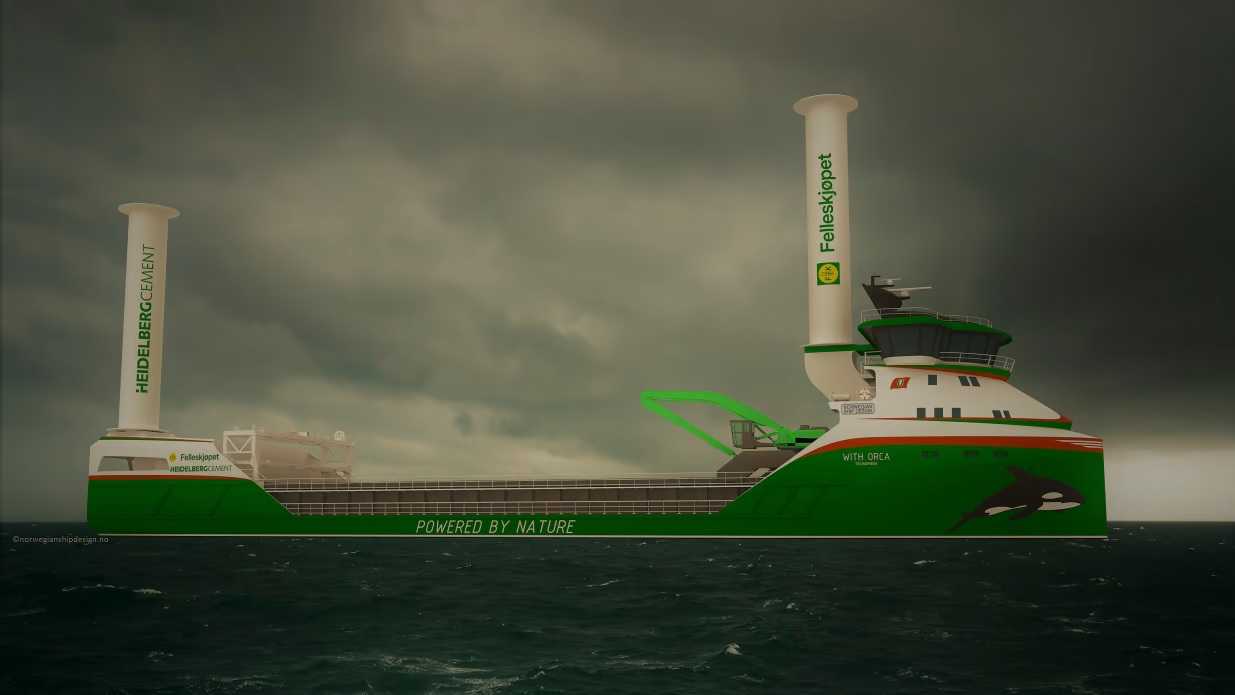The world's first hydrogen - powered cargo ship receives NOK 104 million in support from Enova.

This means that Egil Ulvan Rederi can build the zero-emission cargo ship With Orca. A cargo ship that will sail on a long-term contract for HeidelbergCement and Felleskjøpet Agri, and is scheduled to be put into operation in 2024.
- This is fantastic news, and a crucial milestone for realizing the world's first emission-free bulk carrier. We are terribly proud and humbled by the willingness Enova shows to support our project, says general manager Arild Hoff and shipowner Ivar C. Ulvan in Egil Ulvan Rederi AS.
- Enova supports tomorrow's climate technology. This is a comprehensive and well-worked project with a high level of innovation, which can accelerate fleet renewal in this segment, says CEO of Enova Nils Kristian Nakstad.
What characterizes With Orca is a comprehensive zero-emission concept with hydrogen as fuel and an energy-efficient hull.
- This project will in many ways set the tone for the green shift. The product owners Felleskjøpet Agri and HeidelbergCements meet the strict requirements for tomorrow's emission-free tonnage and are an example of implementation power, says Arild Hoff.
-We have now passed a new milestone in the transition to zero emissions in shipping. Innovative collaboration between product owners, future-oriented energy companies, and an innovative and competitive green maritime industry show the world that zero emissions for cargo ships are possible. Here, Enova is helping to realize a new era for short sea shipping, says Minister of Climate and Environment Espen Barth Eide (Labor)
Wind power saves fuel
The cargo ship shall be equipped with a hydrogen combustion engine, as well as a hydrogen fuel cell and battery, to ensure optimal operation during loading and unloading operations.
The vessel has a number of energy-saving measures such as Flettner rotors. That is, cylinders that spin around in the wind and give the ship propulsion. The specially designed hull, with immersion cooler and adapted rudder solution, makes it possible to utilize the wind to a greater extent than has been demonstrated previously.
-It is estimated that the rotor sails can theoretically provide up to 50 percent savings in fuel. At times, the ship will only run on wind power. When it blows more than the ship needs, the wind power can be used to charge the batteries, says Nakstad.
Another innovative measure is the use of technology for the conversion of heat loss by energy conversion into electrical energy. This is technology that has been used in land-based industry, but which is not widespread on board ships.
-This is a technologically innovative project that we are very proud to now realize. At the same time, the project is also innovative in the form of cooperation between the product owners, the shipping company and the authorities. Hopefully this will be the first of many similar projects both nationally and internationally, says Chief Transport Officer Per-Kenneth Øye in Felleskjøpet Agri and Lars Erik Marcussen, Logistics Manager in HeidelbergCement Northern Europe in a joint statement.
Challenges the market
It all started with a pilot in the Green Shipping Program. The product owners HeidelbergCement and Felleskjøpet Agri, with support from the GSP Service Office for Green Fleet Renewal, took the initiative. They challenged the market by designing a zero-emission vessel that could combine the transport to the two companies.
After a tender competition with approx. 30 shipping companies received the project support from Pilot-E to develop a new ship design. What characterizes the project is a comprehensive zero-emission concept with hydrogen as fuel and an energy-efficient hull.
14 million to Statkraft and Skagerak Energi
Enova also provides NOK 14 million to Statkraft and Skagerak Energi, which have applied for support for investment in a bunkering solution that will supply Egil Ulvan Rederi's hydrogen-powered cargo ship. Hydrogen will be stored in compressed form in replaceable containers, and bunkering will take place by empty containers being lifted off the ship and replaced with full ones.
- This is necessary infrastructure for a hydrogen-powered vessel and therefore in line with Enova's investment in the maritime sector, says Nakstad.
The solutions in this project will be relevant for both near coastal shipping, and to some extent larger cargo vessels.

